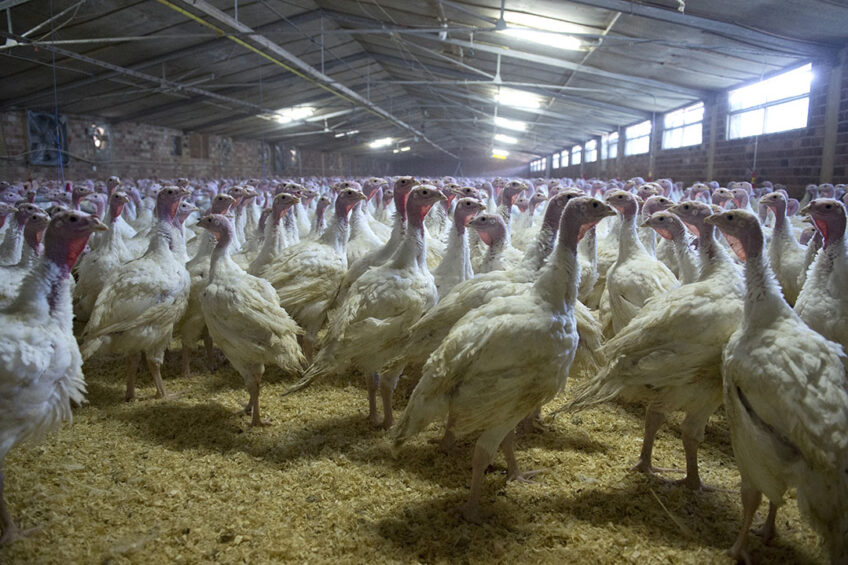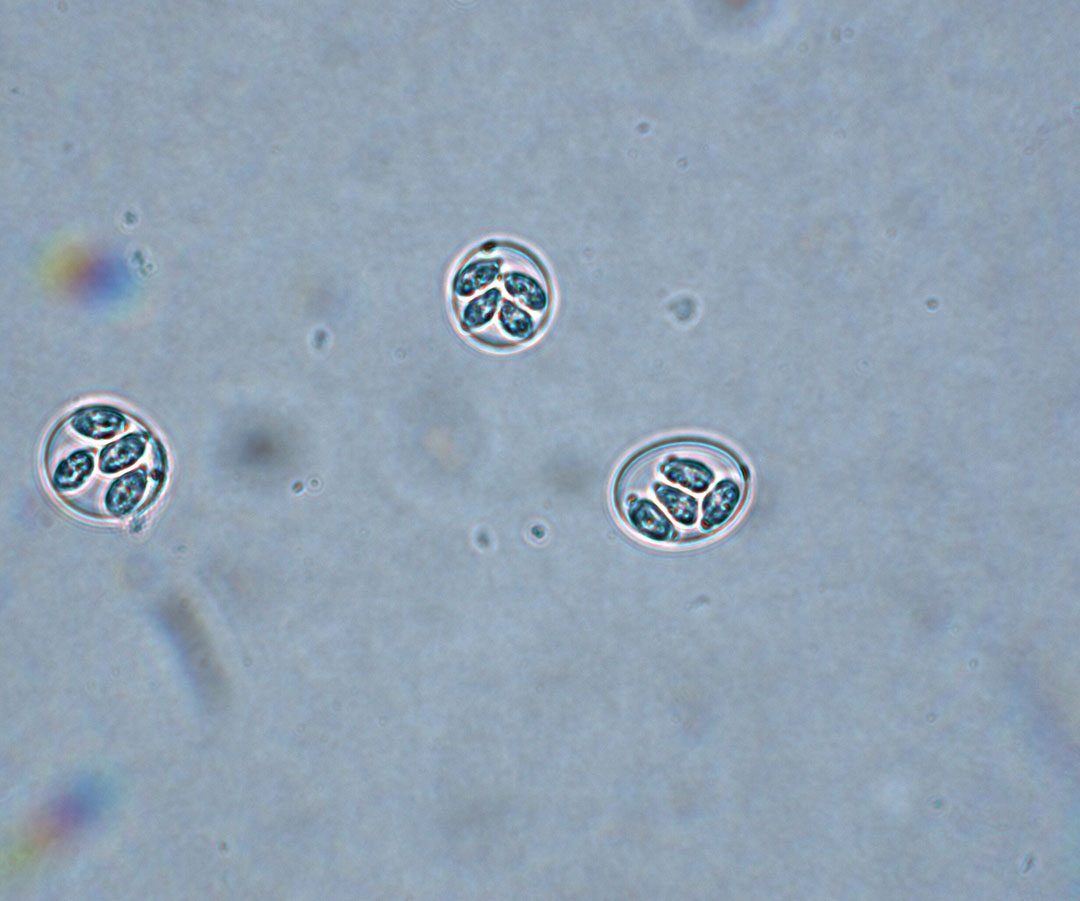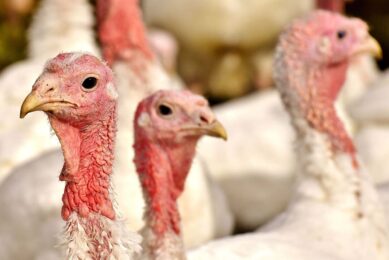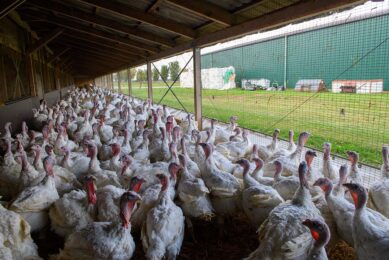Understanding highly pathogenic Eimeria species in turkeys

In recent years, raising turkeys has gained importance in the global market. Rearing healthy turkeys is important for animal welfare, profitable turkey production and for food safety. Among the various diseases, intestinal diseases are a key obstacle in turkey growth since they interfere with the nutrient absorption mechanism and adversely affect the health status of birds.
The intestinal disease coccidiosis is one of the top health issues and a major concern of the turkey industry with a serious economic impact. Coccidiosis compromises the health status of the birds and increases the susceptibility of the turkeys to other infectious agents. Coccidiosis ranked #9 in a 2022 US turkey industry survey of 38 health issues. Most of the time, coccidiosis in turkeys may go unnoticed as the lesions are not as pronounced as in chickens. Coccidiosis has a significant economic impact on the turkey industry in terms of mortality, morbidity, low feed conversion, low production efficiency, poor weight gain, under-sized birds, and increased costs for prophylactic measures/therapy.
Turkey coccidiosis is caused by parasites belonging to the genus Eimeria, family Eimeriidae and phylum Apicomplexa. The 7 species of Eimeria which have been well documented in turkeys are E. adenoeides, E. dispersa, E. gallopavonis, E. innocua, E. meleagridis, E. meleagrimitis and E. subrotunda. Several other species have also been isolated from turkeys but are not well defined. Among the 7 species, 4 species, E. adenoeides, E. meleagrimitis, E. gallopavonis and E. dispersa, are identified as pathogenic to turkeys. Among these 4 species, E. adenoeides, E. gallopavonis and E. meleagrimitis are considered as highly pathogenic as E. dispersa is considered mildly pathogenic.
Eimeria replicates and invades the intestinal cells, undergoing several developmental stages resulting in extensive damage to the intestinal epithelium, which impairs intestinal digestion and absorption. As a sequela, it disturbs the existing microbial community in the intestinal tract and destabilises the intestinal ecology.
In concurrent infections, morbidity and mortality are often attributed to other pathogens. In such instances, the damage caused by other pathogens is overestimated, while the negative impact of Eimeria species is underestimated. For example, if a turkey barn has an undiagnosed subclinical coccidiosis problem and the same barn is infected with histomoniasis, then the total economic losses are attributed to histomoniasis while ignoring the subclinical coccidiosis. Thus, a comprehensive knowledge of turkey coccidiosis helps in understanding the risk factors, pathogenesis, diagnosis and intervention strategies.
Susceptibility
Young turkeys do not acquire passive immunity against coccidiosis from the parental flocks and are, therefore, highly susceptible. Many older birds have developed immunity against coccidiosis due to earlier exposures to Eimeria and are more resistant to clinical disease. However, regardless of age, turkeys that have no exposure to Eimeria are highly susceptible to coccidiosis.
Subclinical and clinical coccidiosis
Subclinical coccidiosis does not exhibit any obvious clinical signs and accounts for low to moderate production losses associated with reduced weight gain and poor feed conversion ratio. Conversely, morbidity and mortality are clearly observed in clinical coccidiosis. Clinical coccidiosis in turkeys causes malabsorption, impaired nutrient absorption, dehydration and watery, mucoid, or blood-tinged diarrhoea (varies between different Eimeria species), resulting in dullness, depression, listlessness, anorexia, huddling, hunched or tucked up stance, and ruffled feathers.
Morbidity and mortality vary between farms and are dependent on the Eimeria species, oocyst burden of the flock, age of the birds, nutritional status, immunity status, concurrent infections, field pressure, litter conditions, and biosecurity. Poor feed quality with mycotoxins can easily aggravate coccidiosis in turkeys. The economic impact of subclinical and clinical coccidiosis is considerably high and underestimated in the turkey industry.
How is coccidiosis spread in the flock?
An infected turkey sheds oocysts in the environment through faecal material. When the oocysts are shed in the faeces, they remain unsporulated. Unsporulated oocysts are non-infective, while sporulated oocysts are infective. Sporulation of the oocyst occurs outside the birds in the litter. Warmth, humidity, and atmospheric oxygen facilitate sporulation of the oocyst – a process that lasts 1-2 days depending on the Eimeria species. The minimum sporulation time for E. adenoeides, E. meleagrimitis and E. gallopavonis are 24, 18 and 15 hours, respectively. A sporulated oocyst has 4 sporocysts and each sporocyst has 2 sporozoites. The sporozoites are the infective portion of the oocyst. When a healthy turkey ingests a sporulated oocyst, it enters the digestive tract. The mechanical action of the gizzard ruptures the oocyst wall and liberates the sporocysts. The protease enzymes and bile salts in the duodenum cause excystation of the sporozoites from the sporocysts. The sporozoites then enter the intestinal mucosa and induce lesions in the intestinal tract. The infected bird sheds unsporulated oocysts in the barn, and once sporulation occurs in the litter, transmission to flock mates is possible. The oocyst burden in the flock, along with a high transmission rate, accelerates the rate of infection in the flock.
Increasing susceptibility to other pathogens
Coccidiosis is a predisposing factor for several enteric pathogens. The lifecycle of Eimeria is complicated, and replication occurs at both an intracellular and extracellular level. As a repercussion of Eimeria replication, the intestinal cells are damaged, providing an optimum niche for other intestinal pathogens, as well as opportunistic pathogens, to invade the intestinal tract resulting in other enteric diseases. Any damage to the intestinal barrier could allow bacterial, viral or parasitic enteritis in the turkeys. Pathogens can easily invade the impaired gut, such as Clostridium perfringens resulting in necrotic enteritis or Histomonas meleagridis resulting in blackhead disease (histomoniasis, histomonosis) outbreaks.
E. adenoeides
The high pathogenicity of E. adenoeides induces lesions primarily in the ceca. The lesions may range from petechia, congestion, edema, necrosis and sloughing of the cecal epithelium. Normal cecal contents may be replaced by abnormal cecal contents ranging from caseous clots to cecal cores. In severe cases, the lesions may extend up to the lower small intestine and the cloaca. The minimum prepatent period is 103 hours (4.3 days). Infection causes dehydration, poor feed conversion, decreased feed intake, reduced body weight gain, and blood-tinged diarrhoea with mucous casts and mortality.
E. meleagrimitis
The high pathogenicity of E. meleagrimitis induces lesions primarily in the duodenum and jejunum of turkeys. E. meleagrimitis replicates in the intestinal cells and results in congestion and haemorrhage. In severe cases, it results in the formation of diphtheritic membranes, sloughing and necrosis. Normal intestinal contents may be replaced with watery and mucoid contents. The minimum prepatent period is 103 hours (4.3 days). Clinical signs could include dehydration, listlessness, and diarrhoea with mucus in the faeces of affected birds. Occasionally, blood-tinged faeces may also be noticed.
E. gallopavonis
E. gallopavonis, one of the highly pathogenic species of turkeys, induces lesions primarily in the lower small intestine extending into the cecal neck and rectum. The lesions may range from white spots on the mucosa, thickened intestinal wall, and haemorrhage to caseous exudate in the lower intestinal tract. In severe cases, the lesions may extend up to the midgut. The minimum prepatent period is 105 hours (4.4 days). The infection causes reduced feed intake, poor feed conversion, poor weight gain, flecks of blood in the faeces, and mortality.
Why is it difficult to eradicate turkey coccidiosis?
Despite several preventive measures available for Eimeria, coccidiosis still remains a threat to the turkey industry. Eimeria species are recognised for their high reproductive potential and are ubiquitous in intense turkey-raising facilities. Eimeria multiplies at a fast rate in the intestine within a week. An infected turkey can shed millions of oocysts and transmit the disease to flock mates within a short period of time. Turkeys, due to their litter pecking behaviour, pick the sporulated oocysts from the litter resulting in transmission of the disease.
The oocysts have a tough and rigid wall that makes them resilient, protecting them against desiccation and commonly used chemical disinfectants. An increase in the oocyst burden results in a high level of contamination of the barns housing infected birds and can easily be carried over to the surrounding facilities.
Coccidiosis intervention strategies
Controlling coccidiosis is a crucial component of successful turkey production. Increased incidences of coccidiosis have been reported in flocks with high bird densities. Under improper management conditions, coccidiosis can be transmitted horizontally between the turkeys in a flock. As sporulation occurs in the litter, effective litter management is crucial. Adequate ventilation and prevention of water leaks can reduce the moisture in the litter. Increasing the downtime period and following the standards for bird density also minimises the risk of coccidiosis. Thus, good farm management practices, along with strict biosecurity measures, are recommended.
Anticoccidial drugs (such as ionophores) and chemicals are administered in feed to control coccidiosis in turkeys. Proper shuttle and rotation programmes can ensure adequate control with minimal risk of developing resistance. Shuttle programmes consist of changing coccidia interventions in the same flock, such as chemical anticoccidial during the brooding phase and switching to an ionophore for grow out. Changing interventions between flocks is referred to as a rotation programme, such as an ionophore in the summer flocks and a chemical during the winter.
Phytochemicals have also been used to help control coccidiosis and manage overall intestinal health. Programmes may utilise phytochemicals to supplement the current anticoccidial programme, having purported, either direct or indirect, activity against coccidia. Live vaccines are available to combat coccidiosis in turkeys. The United States Department of Agriculture’s conditionally-licensed coccidiosis vaccine has only 2 species of Eimeria. Immunity against Eimeria is species-specific, meaning that if the poults are vaccinated against a particular species, then protection is offered only for that species. No cross-protection is noticed among the different Eimeria species.
Antibiotic Free (ABF), Raised Without Antibiotics (RWA) and No Antibiotics Ever (NAE) programmes do not permit the use of ionophore anticoccidials and some programmes prohibit Food and Drug Administration-approved chemical anticoccidials, so coccidiosis control is limited to phytogenics or vaccination. A holistic approach with a robust gut health programme needs to be established and emphasised in turkey flocks to prevent coccidiosis. Maintaining intestinal integrity is the key to successful turkey farming. A strict gut health programme with an effective coccidiosis control strategy is part of healthy and profitable turkey production.
References are available upon request.
Join 31,000+ subscribers
Subscribe to our newsletter to stay updated about all the need-to-know content in the poultry sector, three times a week."*" indicates required fields

More about
 Beheer
Beheer










 WP Admin
WP Admin  Bewerk bericht
Bewerk bericht